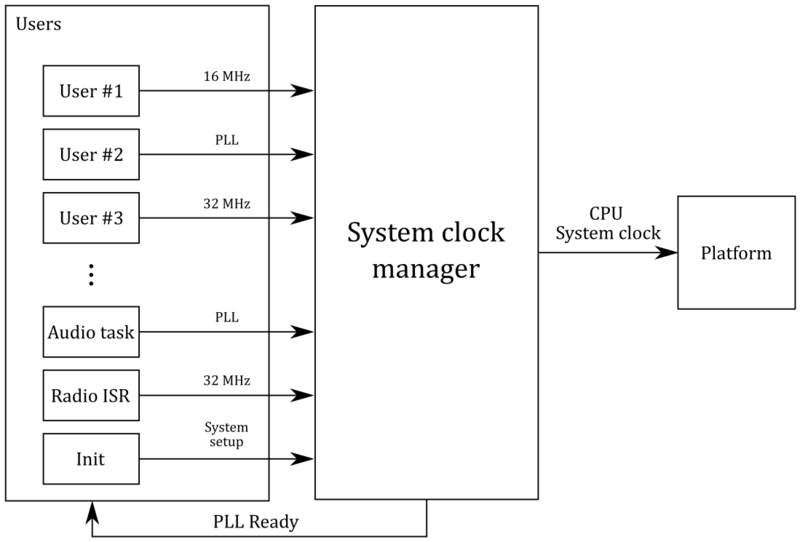1. Introduction
The system clock manager (SCM) is the module that manages the CPU system clock source and frequency. It defines different users that can request different configurations. It determines which one suits the system and user needs best.
2. Features
2.1. SCM users principle
The module is based on a client request mechanism. The SCM defines (up to 32) users that can request a modification of the clock frequency. Two users are defined by default: SCM_USER_LL_FW (system user for link layer purposes) and SCM_USER_APP (application-related user).
All users have the same weight/priority.
Among the requests, the system clock manager determines the one that fulfills all the needs. The best system clock evaluation is realized at each new request.
2.2. Supported configurations
2.2.1. Overview
Supported configurations are fixed. Unlike SCM users, it is not possible to add SCM configurations over existing ones.
Each SCM configuration has a defined purpose.
The table below presents all supported configurations (in an increasing order of priority) and their use by the system.
| SCM configuration | Purpose |
|---|---|
| HSE 16 MHz Low priority |
Nominal - no radio activity. Requested in radio interrupt. (Ending radio event notification from link layer.) |
| HSE 32 MHz | Radio activity. Requested in radio interrupt. (Starting radio event notification from link layer.) |
| PLL High priority |
PLL is used for high-performance use cases (e.g. Bluetooth® Low Energy audio). |
2.2.2. Corresponding SoC configuration
To achieve these configurations, the SCM module is responsible for adapting several SoC-related parameters:
- Flash memory & SRAM latency.
- Regulator supply output voltage (VOS).
- AHB5 divider.
They are presented per SCM configuration in the table below.
| SCM configuration | Flash & SRAM latency | VOS | AHB5 divider |
|---|---|---|---|
| HSE 16 MHz | Flash latency: 1 SRAM1/2 latencies: 1 |
2 | 2 |
| HSE 32 MHz | Flash latency: 0 SRAM1/2 latencies: 0 |
1 | 1 |
| PLL | Flash latencies: 3 SRAM1/2 latency: 0 |
1 | 1 |
2.3. PLL usage
PLL usage and configuration are defined as follows:
- The PLL source is always HSE 32 MHz.
- If there is one global PLL configuration for SCM, the PLL parameters (PLL mode, PLL multiplier, and dividers) can be adapted to the user needs with dedicated interfaces. Refer to the PLL management interfaces section for more information.
2.4. Low-power management
The SCM module is used in low-power management for both low-power entry and exit.
- For low-power-mode entry (Stop1 or Standby), the SCM interface
scm_setwaitstates(LP)is used for adapting the flash memory & SRAM latencies. - For low-power-mode exit (Stop1 and Standby), the SCM interface
scm_setup()is used for applying the system clock configuration used before low-power entry. Regarding Standby-mode exit, the PLL configuration is reapplied (even if not used at that time) because the PLL registers have been reset.
2.5. SCM configuration update
On the one hand, decreasing the clock speed is handled immediately.
On the other hand, increasing the clock speed requires more time to set up (enabling the oscillators, propagation delays, PLL lock, etc.). To ensure system performance and radio activity timing, the SCM implements an interrupt-based mechanism.
Indeed, when the system clock source has to be changed, the targeted oscillator (HSE or PLL) is enabled alongside dedicated RCC ready flags. The other part of the system clock configuration is done in the RCC interrupts directly when the clock is ready. This allows the firmware to continue running with the actual clock source and speed until the targeted clock is ready.
The SCM handles two RCC interrupts:
- RCC HSE ready flag (raised just after low-power-mode exit, with the system clock on HSI 16 MHz).
- RCC PLL ready flag (always raised when the system clock is on HSE, because HSE is the PLL source clock).
2.6. SCM concept summary
The following diagram summarizes the SCM module:
3. Interfaces
3.1. SCM users
The available SCM users are listed in the table below.
| SCM user | Description |
|---|---|
| SCM_USER_LL_FW | Link-layer system user. Requests system clock changes on radio, starting/ending radio activity. |
| SCM_USER_APP | Application-related user. Requests system clock changes for application needs. |
3.2. SCM functions
3.2.1. General interfaces
| scm_init |
|---|
|
Description
|
| scm_setsystemclock |
|---|
|
Description
|
| scm_setwaitstates |
|---|
|
Description
|
| scm_notifyradiostate |
|---|
|
Description
|
3.2.2. Low-power management
| scm_setup |
|---|
|
Description
|
| scm_standbyexit |
|---|
|
Description
|
3.2.3. PLL management
| scm_pll_setconfig |
|---|
|
Description
|
| scm_pll_fractional_update |
|---|
|
Description
|
| scm_pllready |
|---|
|
Description
This function is defined as weak in the SCM module and can be overridden by the user.
|
3.2.4. RCC ISR handling
| scm_hserdy_isr |
|---|
|
Description
|
| scm_pllrdy_isr |
|---|
|
Description
|
4. How to
4.1. Initialize the SCM
To initialize the SCM module, the scm_init function has to be called before any connectivity host stack initializations (this sets up the link layer). scm_init is responsible for retrieving the current system clock configuration (which is done in the common HAL function SystemClock_Config, in the main.c file) to set up the internal context.
From this point on, users can request system clock changes.
4.2. Request a system clock change
To request a system clock change with the SCM, the only function to call is scm_setsystemclock. This function takes two parameters:
- The SCM user making the request.
- The configuration to apply.
